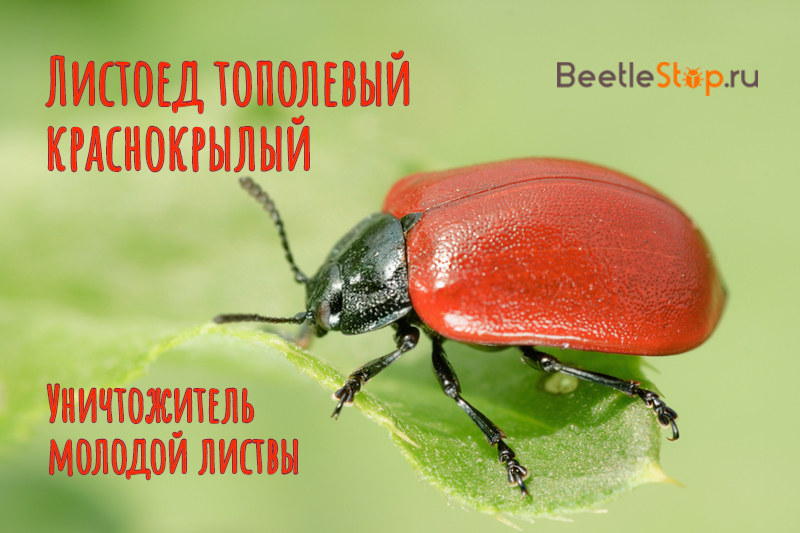Poplar beetle - red-winged enemy of trees
A large family of herbivorous leaf-eating insects (Chrysomelidae) has 35 thousand species. About 200 of them are pests of beneficial plants. On a vast territory from Europe to the Far East, leaf beetle is found. The insect feed plants are poplar and willow. During the years of mass breeding, beetles completely destroy the young foliage of protective plantings. In such cases, insecticides are used against poplar leaf beetles.

View description
Often to the name of the insect the leaf beetle poplar is added by the red-winged epithet. Brightly colored convex elytra is a characteristic feature of the species Chrysomelapopuli. Beetles belong to the family of leaf beetles, the subfamily chrysomeline. Body length 10-12 mm, color black and blue with a metallic sheen. The pronotum is narrowed in the anterior part. On the sides are two longitudinal ridges covered with dotted punctures. The middle keel is smooth.
Elytra red, uniformly convex. The pronounced shoulder tubercle ends in a dark spot. Along the lateral edge passes a series of points. Wings are transparent, darkened, well developed. Antennae consist of 11 segments, directed forward. In case of danger, beetles hide antennas and paws under the body.
Distribution area
Poplar leaf beetle is the most common member of the Chrysomelidae family in the Palearctic. Insects are found in Europe, Central Asia and the Far East. Beetles live in the Caucasus, in Pakistan, Kazakhstan, Siberia, China and Japan. The species was introduced to North America.
Lifestyle & Reproduction
The habitats are mixed and deciduous forests where fodder trees grow. They are found on the banks of ponds when they settle on shrubby willows. The red-winged leaf beetle feeds mainly on young leaves of white, black, balsamic poplar. Insects are found on purple and rod-shaped willow, aspen.
Interesting fact. Not all willows are suitable for feeding Chrysomelapopuli larvae. Insects feeding on black and Babylonian willow quickly die.
Adult years are observed from April to September. Double generation is characteristic. Second-generation beetles that emerged from cocoons in September remain wintering. From the cold they hide under the fallen leaves. With the onset of warm weather, adults appear on trees for additional nutrition before breeding. In the southern regions, beetles wake up in March-April, in the northern regions in May.
Breeding
Females lay eggs on the underside of the leaves. A pile of 20-30 pieces is placed on one plate. In total, the female lays from 100 to 100 eggs per season. Larvae appear after 7-10 days. They skeletonize leaves, leaving veins. Larvae are fusiform, with a thick abdomen. At the last age they reach 13 mm. Body color is light, black spots and tubercles on each segment, short hairs on the sides. Head and limbs are black, pronot is brown.
After two molts, pupation occurs, in the first generation in July, in the second in August. Pupa 11 mm long, light yellow with a black pattern, hanging upside down. This stage lasts 10 days. By September, young adults appear.
Interesting fact. In case of danger, the larvae are covered with drops of poisonous liquid.The protective mechanism allows them to lead an open lifestyle.
Related view
One of the subfamilies of the chrysomelinlistoed aspen (Chrysomelatremula) is very similar to the leaf beetle. The body of the imago is black with a blue or green tint. Elytra red or yellow-red, more convex in posterior part. Young larvae are dark; after birth they keep in groups. With age they become lighter. Their body is covered with black tubercles and sclerites. Beetles settle on aspens and poplars.
Information. You can distinguish representatives of two species of Chrysomela in size, aspen leaf beetle is 2-3 mm smaller.
Beetles belong to the group of forest pests. Two generations are replaced in a year. With mass reproduction, insects strongly harm feed plants. Young trees in nurseries are especially affected. Habitats are forests, clearings, thickets along the banks of water bodies.
Pest Management Methods
In the case of an increase in the leaf beetle population, the following measures are applied:
- Trees are sprayed with a solution of organophosphorus compounds or pollinated with a 5.5% dust of DDT and HCH. The use of insecticides ensures the death of insects at any stage of development.
- The biological method is the attraction of insectivorous birds.
To prevent the propagation of pests, it is recommended the creation of mixed closed stands and shrubs.

